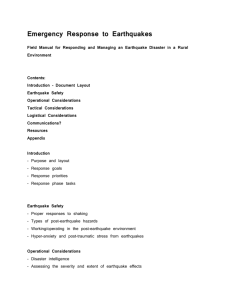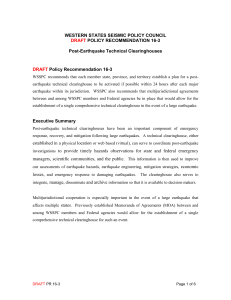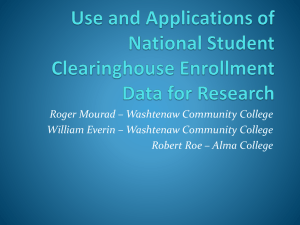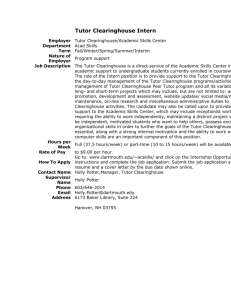1356118877-DRAFT_PR_13-3_Clearinghouse_111412
advertisement
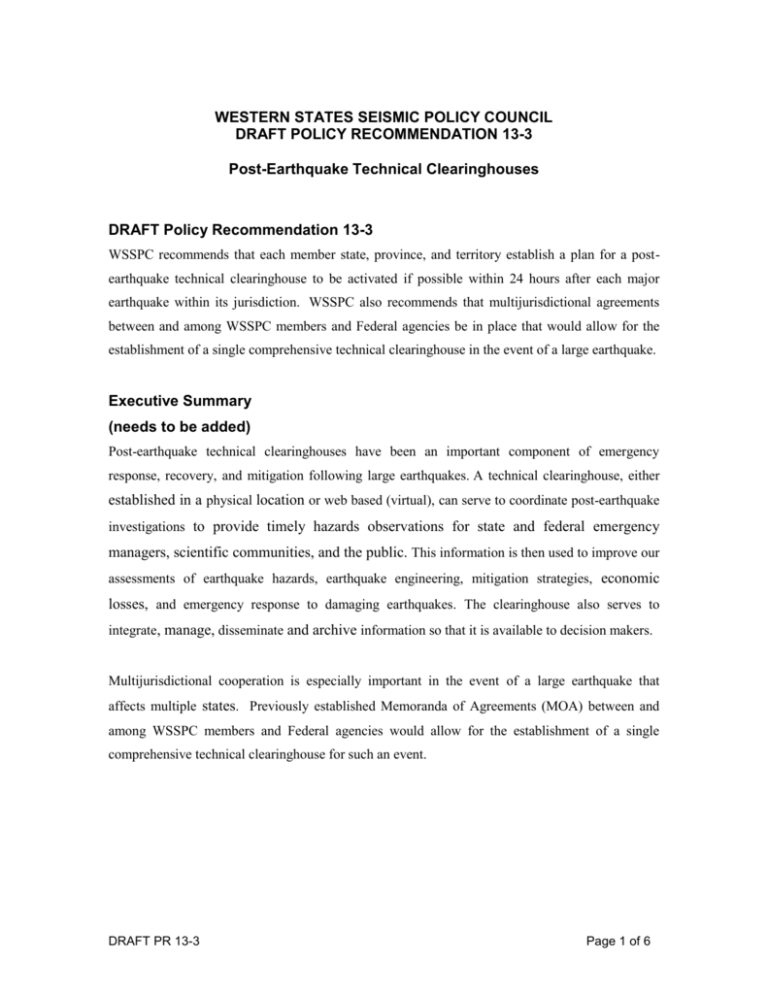
WESTERN STATES SEISMIC POLICY COUNCIL DRAFT POLICY RECOMMENDATION 13-3 Post-Earthquake Technical Clearinghouses DRAFT Policy Recommendation 13-3 WSSPC recommends that each member state, province, and territory establish a plan for a postearthquake technical clearinghouse to be activated if possible within 24 hours after each major earthquake within its jurisdiction. WSSPC also recommends that multijurisdictional agreements between and among WSSPC members and Federal agencies be in place that would allow for the establishment of a single comprehensive technical clearinghouse in the event of a large earthquake. Executive Summary (needs to be added) Post-earthquake technical clearinghouses have been an important component of emergency response, recovery, and mitigation following large earthquakes. A technical clearinghouse, either established in a physical location or web based (virtual), can serve to coordinate post-earthquake investigations to provide timely hazards observations for state and federal emergency managers, scientific communities, and the public. This information is then used to improve our assessments of earthquake hazards, earthquake engineering, mitigation strategies, economic losses, and emergency response to damaging earthquakes. The clearinghouse also serves to integrate, manage, disseminate and archive information so that it is available to decision makers. Multijurisdictional cooperation is especially important in the event of a large earthquake that affects multiple states. Previously established Memoranda of Agreements (MOA) between and among WSSPC members and Federal agencies would allow for the establishment of a single comprehensive technical clearinghouse for such an event. DRAFT PR 13-3 Page 1 of 6 Background Post-earthquake technical clearinghouses have been an important component of emergency response, recovery, and mitigation following large earthquakes. Seismologists deploy instruments that measure aftershocks and investigate the mechanics of earthquakes. Geologists and geotechnical engineers document ground failures, including fault displacements, fissures, landslides, rock falls, and liquefaction. Geodesists investigate ground deformation and related strain. Structural engineers evaluate the effects of the earthquake on various types of buildings, bridges, dams, utilities, and other structures. Social scientists study direct and indirect impacts to people and businesses. This information is then used to improve our assessments of earthquake hazards, earthquake engineering, mitigation strategies for nonstructural hazards, and emergency response to damaging earthquakes. The data collected in the days immediately following a major earthquake can be critical during emergency response and recovery. Scientists and engineers can determine the likelihood that landslides will move (from rain or aftershocks), and can assess the susceptibility of structures to collapse. Some data are perishable and must be collected as soon as possible, before erosion or bulldozers eliminate the evidence or before aftershocks die out. Data collected through clearinghouses help us to be better prepared for future large earthquakes. In addition, data on strong ground motion and damage to buildings helps to calibrate loss-estimation models. The Federal Emergency Management Agency’s (FEMA) HAZUS, can be an important component of a Governor's or the President's disaster declaration as well as provide useful information for response, recovery and hazard mitigation. A technical clearinghouse, either physical or web based (virtual), can serve to coordinate postearthquake investigations and to share resources and information among investigators. The clearinghouse also serves to integrate and disseminate information so that it is available to decision makers and the media. Post-earthquake technical clearinghouses were successfully implemented following the Landers, California (1992); Northridge, California (1994); Nisqually, Washington (2001); and Wells, Nevada (2008) earthquakes. A clearinghouse provides a place for scientists and engineers to report DRAFT PR 13-3 Page 2 of 6 on their findings each day. In some post-earthquake situations, a clearinghouse may serve as one of the chief mechanisms for relaying critical information from scientists and engineers investigating the earthquake to emergency managers. Only California, Utah, and Nevada have developed plans for post-earthquake technical clearinghouses. Few WSSPC members have the resources to fully staff and operate a clearinghouse. Opportunities exist for members to collaborate with one another and to coordinate with the U. S. Geological Survey (USGS), FEMA, Earthquake Engineering Research Institute (EERI), university researchers, and other groups. The National Earthquake Hazards Reduction Program (NEHRP) agencies (USGS, FEMA, National Institute for Standards and Technology, and National Science Foundation) developed The Plan to Coordinate Post-Earthquake Investigations in 2003 (USGS Circular 1242) that includes provisions for cooperating with states to establish post-earthquake technical clearinghouses. Under this plan, the NEHRP agencies can step in and take the lead if WSSPC members are not prepared to establish a clearinghouse. Multijurisdictional cooperation is especially important in the event of a large earthquake that affects multiple WSSPC members. Previously established Memoranda of Agreements (MOA) between and among WSSPC members and Federal agencies would allow for the establishment of a single comprehensive technical clearinghouse for such an event. DRAFT PR 13-3 Page 3 of 6 Facilitation and Communication WSSPC recommends that its members establish a plan for a post-earthquake technical clearinghouse (physical or virtual as circumstances dictate) to be activated if possible within 24 hours after a major earthquake within its jurisdiction. WSSPC further encourages its members to form MOAs to facilitate the operation of clearinghouses, including sending employees from one jurisdiction to another to assist in collection of field data and in staffing a clearinghouse. WSSPC will construct a roster of experts who are willing to participate and disseminate information on clearinghouses that are established after an earthquake. The NEHRP agencies’ post-earthquake investigations plan specifies coordination with states to operate clearinghouses. WSSPC members should develop MOAs with NEHRP agencies to facilitate clearinghouse staffing and operations, and to specify whether a member wishes the NEHRP agencies to take responsibility for establishing a clearinghouse. These MOAs could include triggers, such as USGS or EERI deployment only if moment magnitude or earthquake intensity exceeds certain values for an urban epicenter or for a rural earthquake. WSSPC members may wish to activate clearinghouses at lower triggers for purposes of training or when sufficient resources exist to respond to the earthquake. Any MOA should recognize the considerable role and interest of FEMA in post-earthquake technical clearinghouses. To achieve the above goals, WSSPC will establish a Post-Earthquake Technical Clearinghouse Committee (PTCC) to update the WSSPC model post-earthquake technical clearinghouse plan, create a model virtual clearinghouse template for use by WSSPC members, and develop model MOAs for use among members and between members and NEHRP agencies for post-earthquake technical clearinghouse operation and assistance. PTCC should conduct workshops and use other means to help members establish individual post-earthquake technical clearinghouse plans and implement clearinghouse MOAs. WSSPC recommends that the USGS provide mirrored or parallel access to its post-earthquake website. One ultra-high volume portal should be available to the general public. A second, password-protected site should be maintained. State emergency management agencies, state geological surveys, state seismic safety commissions and councils, earthquake consortia, university DRAFT PR 13-3 Page 4 of 6 seismological laboratories, and engineering-research centers should have access to the passwordprotected site. WSSPC recommends that emergency response and recovery plans incorporate and refer to postearthquake technical clearinghouse plans. There should be links between the technical clearinghouse and emergency management operations. Because the clearinghouse can provide vital information during emergency response and recovery, FEMA should work with emergency managers to assure that appropriate federal funding and FEMA staff support are provided for the clearinghouse, whenever a clearinghouse is established following an earthquake. Once members have established post-earthquake technical clearinghouse plans, WSSPC recommends that they hold regular training sessions and exercises to ensure readiness and compatibility with other emergency response functions. WSSPC also recommends that those responsible for mobilizing post-earthquake clearinghouses participate in large-scale earthquake exercises sponsored by states or local jurisdictions to test procedures that link research activities with emergency operations centers. Funding will be required to pay travel to update WSSPC’s model post-earthquake technical clearinghouse plan, create a virtual clearinghouse template, prepare model MOAs, and hold workshops. WSSPC and the PTCC should take the lead in developing a proposal to acquire the necessary funding if work cannot be performed at WSSPC annual meetings and by electronic means. Assessment Measures of the success of this Policy Recommendation will be (1) the number of additional WSSPC members that develop post-earthquake technical clearinghouse plans, and (2) the number of MOAs established to facilitate clearinghouse operation. A periodic assessment should be made to determine the number of functioning clearinghouse plans and supporting MOAs. WSSPC will periodically update its model post-earthquake technical clearinghouse plan, and will post this and individual member plans on the WSSPC website. DRAFT PR 13-3 Page 5 of 6 History Policy Recommendation 10-3 was first adopted as Policy Recommendation 01-3 by unanimous vote of the WSSPC membership at the Annual Business meeting October 24, 2001. PR 01-3 was revised and re-adopted as PR 04-3 by unanimous vote of the WSSPC membership at the Annual Business meeting September 30, 2004. The Background section was revised and PR 04-3 was readopted as PR 07-3 by unanimous vote of the WSSPC membership at the Annual Business Meeting October 3, 2007. PR 07-3 was re-adopted as PR 10-3 by a majority voice vote of the WSSPC membership with Hawaii voting against the policy recommendation at the Annual Business Meeting July 9, 2010. DRAFT PR 13-3 Page 6 of 6
